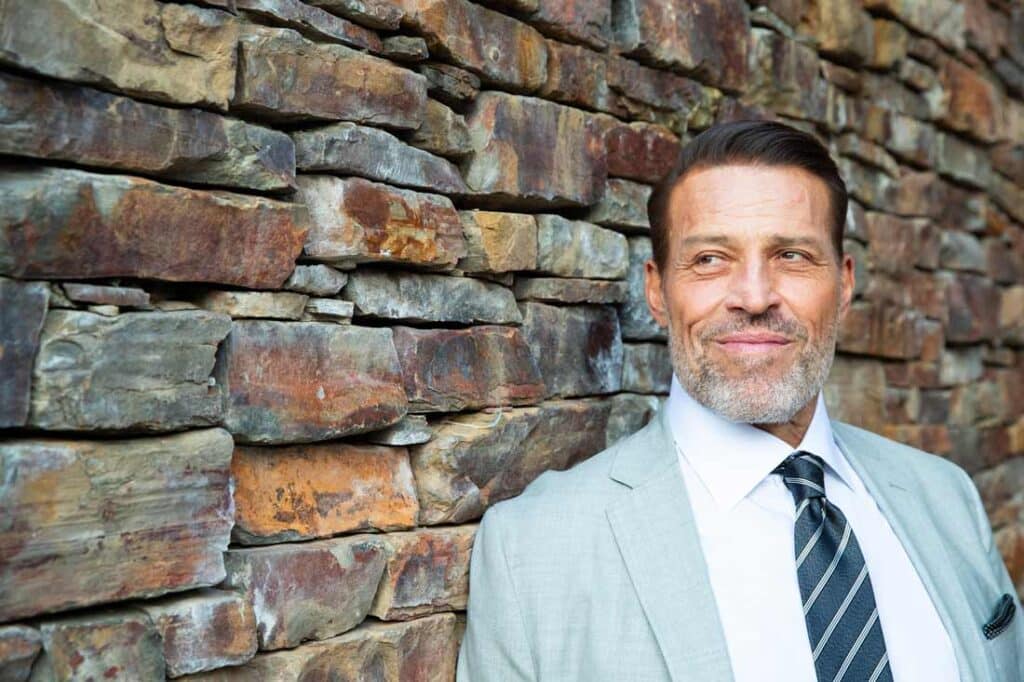When you hear the words “financial abundance,” few names resonate as powerfully as Tony Robbins.
Today, more than four decades after he began teaching people how to achieve personal fulfillment and obtain the lives they seek, the towering 64-year-old native Californian is known the world over for his many practical lessons on achieving personal prosperity, health and wealth. More than 100 million people across 193 countries, including world leaders, celebrities and financial titans—four U.S. presidents, Nelson Mandela, Princess Diana, Oprah Winfrey, Ray Dalio and Paul Tudor Jones, to name a few—have benefited from his coaching wisdom.
It was quickly apparent during a recent conversation with Robbins why so many people from so many walks of life turn to him. His own life purpose is to help as many people as possible achieve an abundant life, no matter their current situation in the world.
Tony Robbins new book: The Holy Grail of Investing
During our lengthy conversation, perfectly timed for SUCCESS’ first Money issue, Robbins doesn’t hesitate to discuss his own path to financial abundance and his investing practices, the latest lessons he has included in his just-released financial freedom book, The Holy Grail of Investing, which debuted in February 2024 at #1 on Amazon’s bestsellers list.
Robbins begins by passionately jumping right in to explain how simple personal mindset shifts stacked on top of one another over time can help build the life you want. When it comes specifically to building financial abundance through wealth building, Robbins emphasizes that 80% of wealth building is psychology, the other 20% is mechanics. First, to create financial abundance in your life, Robbins says one must remove their limiting beliefs about money. Money has no power by itself, only the power someone gives it. By understanding this, Robbins says individuals can transform their limiting beliefs to empowering beliefs around wealth building. Examples of empowering beliefs include “I deserve to make money” or “I will use the money I make to create a positive impact on the world.”
Robbins recalls growing up with nothing and scraping pennies together to buy his first suit. “My life has been a tumultuous lesson since day one,” Robbins says. “If my mom was the mother that I wish she was, I wouldn’t be the man I am today. We had no money, no food.”
His plethora of personal experiences—both positive and not—and resulting success stories from his own rags-to-riches life serve as understandable access points to help guide those seeking not just financial prosperity, but a fulfilling and purpose-driven life.
Tony Robbins’ road to success has been a long one
With as much enthusiasm today as when he made his first million dollars at age 24, Robbins has a natural ability to draw you into a conversation with an infectious energy. Although a serial entrepreneur since his teens, Robbins explains finding his own financial freedom did not come without setbacks. “My obsession [with entrepreneurship] started with finding a way to do more for others and taking calculated risks,” Robbins says. “However, my success has not been without a lot of blood, sweat and tears.”
After many years of success—and yes, failure—Robbins today sits atop a phenomenal multibillion-dollar brand that includes live and virtual training programs and seminars, seven internationally bestselling books, more than 25 million social media followers and a successful podcast that reaches millions more. On top of this, the serial entrepreneur is connected to more than 100 other businesses and is involved with a global foundation to make a significant difference in the quality of life of people often forgotten.
Robbins is open and thankful for the financial abundance and success he has achieved over his lifetime. It is in this moment that you can appreciate his complete story and why he is adamant that financial abundance comes to those with a hunger for hard work, continuous learning and development, constantly adding more value to the next person and a willingness to do well by also doing well for others.
The Holy Grail of Investing lays out mindset shifts for personal wealth building
Robbins has carved a niche for himself in the realm of wealth management, investing and entrepreneurship. The Holy Grail of Investing (2024) with co-author and renowned investor Christopher Zook is the third in a financial freedom trilogy that also includes the #1 New York Times bestsellers, Money Master the Game: Seven Simple Steps to Financial Freedom (2014) and Unshakeable: Your Financial Freedom Playbook (2017).
At the core of Robbins’ wealth-building philosophy lies the transformative power of mindset shifts. He advocates that to be abundant you must transition from a consumer mindset to an owner mindset. “This is the only way you’re going to embrace the value of owning a stake in successful enterprises rather than merely consuming their products,” he says. “The problem is that most people operate as financial traders, exchanging their time for money, but wealth is built by creating value and owning a portion of something substantial.”
Luckily, Robbins is an expert at molding his lessons into digestible nuggets. Illustrating the power of compounding and the concept of making money while you sleep, Robbins shares the inspiring story of Theodore Johnson. A UPS employee who never earned more than $14,000 in a year, Johnson was eventually worth a staggering $70 million. The secret to his success? Consistently investing 20% of his income and allowing compounding to work its magic.
Robbins emphasizes that building wealth doesn’t require immense sums of money; rather, it necessitates compounding and time. The story of Johnson serves as a powerful example, challenging the conventional belief that significant income is a prerequisite for financial success. Ultimately, if he can do it, so can you.
Be an owner, not a consumer
One of Robbins’ most profound insights about reaching personal financial abundance is that people need to transition from mere consumers to owners.
Among the insights included in The Holy Grail of Investing is the investing and wealth-building counsel of more than a dozen of the world’s most successful investors who have been making outsized returns as “owners” in private equity, private credit, private real estate and venture capital for decades.
In speaking with these great investors and many others during the past 15 years, Robbins has identified the fundamental mindset shift that sets the foundation for building personal wealth: it’s the decision to become an owner, not merely a consumer. These financial titans interviewed by Robbins for his latest book are the owners of the firms who actually manage the private assets while also sharing in the revenue they generate. Looked at another way, Robbins says, you can buy a new Apple iPhone as a consumer, or you can buy Apple stock and become an owner and share in the profits of global iPhone sales.
In a society driven by consumption, where material possessions often define one’s identity, Robbins challenges individuals to break free from the consumer mentality that dominates society today. More than anything, Robbins and the investors he talked to in writing The Holy Grail of Investing recognize the significance of owning a piece of successful companies, shifting the focus from immediate gratification to long-term wealth creation.
Making more money isn’t everything
He cautions against the notion that making more money equates to building wealth. Drawing examples from personal experiences and friends who have made a name for themselves in business, such as Mike Tyson and Richard Branson, Robbins stands true to his mantra that true wealth is generated through ownership, not income. “Richard Branson negotiated for a year and a half to get Boeing to finally agree he could buy all these planes, but only if after a year and a half, he didn’t make it. He could return the planes and no loss financially and no loss to his credit.”
When it comes to scaling your business, Robbins discusses the nuances of starting a business while maintaining a full-time job. “The importance of clarity regarding one’s passion and responsibilities is critical when considering the time and effort required for success.” Robbins and his wife Sage both exemplify this principle, each finding fulfillment in different ways—she in helping a few with a personal touch, and he in reaching millions through his business and philanthropic efforts.
Personal development and financial success
To this day, Robbins draws inspiration from a mentor from his youth, Jim Rohn, an Idaho farm boy who made it big as a motivational speaker and author by holding seminars across the country for 40 years. “Rohn taught me that working harder on oneself becomes a mantra for success above everything else. He emphasized the continuous pursuit of knowledge, skills and self-improvement—and this focus on personal growth positions individuals as valuable contributors in the marketplace.” In other words, becoming a creator of value is the key to earning more in the marketplace. “The intersection of personal and professional development is crucial for entrepreneurs and business leaders in order to create a synergy that propels them toward success.”
Robbins reveals a pivotal lesson he learned from Warren Buffett during an interview with the “sage of Omaha” a decade ago for his book, Money: Master the Game. He recalls asking Buffett about the most crucial investment one could make, expecting a response related to stocks or companies. His profound answer shifted the paradigm. The most important investment, according to the legendary investor, is in oneself.
Buffett attributes his success not only to financial acumen but to the investment he made in communication skills, citing his attendance at Dale Carnegie’s course as a transformative experience. “His belief that enhancing one’s skills and abilities is an investment that lasts a lifetime, remains nontaxable and directly correlates with increased value,” Robbins says. “Buffett’s emphasis on continuous self-improvement is the basis of personal development, which is a theme that I passionately endorse.”
Communication is key
Robbins echoes Buffett’s sentiment that investing in oneself is the foundation for lasting success. By continuously developing interpersonal skills and abilities, individuals become more valuable contributors in their respective professional fields—hence, obtaining the ability to make more money.
Robbins says the ability to articulate ideas and negotiate is a key factor in achieving success. He shares Buffett’s insight that without refined communication skills, brilliant ideas may wither away. As a result, his perspective on building fundamental skills extends far beyond traditional financial investments.
Additionally, Robbins has found through experience and interactions with thousands of business owners that business itself is a spiritual game and says that entrepreneurs should focus on impact rather than just monetary gain. “This mindset is crucial for sustained success.” Even during uncertain times like the COVID-19 pandemic, he offered free events to support communities—displaying his value creation commitment and teaching. “This is why I do what I do, but it’s also why I encourage entrepreneurs to focus on enhancing their mindset when seeking financial success.”
Entrepreneurship and risk tolerance
His many insights on the road to financial freedom aim to guide others in avoiding common pitfalls, providing a roadmap for investing and scaling businesses and maintaining a more modest approach to building wealth.
Robbins urges business owners to identify their true purpose and goals by understanding their business’s position in its life cycle. He also advises that hiring the right talent is critical as you build and grow—and you should determine whether you need a long-term fit rather than short-term proficiency. “The importance of taking calculated risks in business is important to highlight the search for asymmetrical risk-reward scenarios,” Robbins says. “A person’s willingness to embrace risk in pursuit of passion, even in the face of potential losses, epitomizes the mindset shift that I am talking about.”
Overcoming challenges in achieving personal wealth
Robbins admits that he has faced criticism on a national stage in the past, but he learned to push through the negativity and stand up for his methods in the face of skepticism. His inspiring words come from a place of vulnerability and facing challenges head-on. He’s not afraid to be honest and stresses that it’s the only way to push through setbacks and learn from your mistakes.
“The entrepreneurial trap is getting into business, having all these great goals and dreams, but not knowing how to run it,” he says. “That’s why I do things like Business Mastery, where I take people in a boot camp for five days or 10 days of my time there. I can turn any business from 30% to 130%. However, what people have to understand is that if you’re a leader, you have to solve problems; otherwise someone else is going to do it for you.”
Robbins encourages entrepreneurs to understand their innate wiring and motivations. He cautions against blindly succumbing to the allure of entrepreneurship without genuine passion and competence. For instance, Robbins categorizes individuals into three common patterns: the artist, the manager leader and the pure entrepreneur. Recognizing these patterns helps individuals align with roles that resonate with their natural tendencies and strengths.
He says self-awareness is important in pursuing any passion, noting for instance that “not everyone is suited for entrepreneurship.”
Being self-employed vs. business owner
While self-employment may be a valid choice for some, Robbins warns of the burnout associated with being an operator in a growing business. He advocates for aspiring business owners to learn or partner with individuals possessing entrepreneurial or managerial leadership skills to build a business and foster sustainable growth.
When it comes to wagering whether an individual should quit a full-time job to pursue an entrepreneurial dream of making millions, Robbins recommends that you don’t put all your eggs in one basket. “I wouldn’t rely solely on passion without practical considerations when venturing into business,” Robbins says. “In all honesty, you shouldn’t jeopardize your financial stability or your family’s well-being in the pursuit of passion.
“Entrepreneurship is not about the end goal of achieving everything you want; it’s about setting goals and aspiring to reach them along the way but putting everything you have into the process,” he adds. “Entrepreneurship is not for the faint of heart.”
Diversification and risk-management strategies
Robbins’ investment philosophy centers around setting aside a portion of an individual’s income into an investment account. He highlights the importance of following the No. 1 rule of making money from investing, which is first to not lose money. Asset allocation, Robbins shares, is the cornerstone of financial freedom and the creation of a “money machine.”
The Holy Grail of Investing book title comes from this notion. That Holy Grail was identified for Robbins during a conversation with his friend Ray Dalio, a self-made billionaire, investor and founder of the largest hedge fund in the world, Bridgewater Associates.
Dalio’s Holy Grail principles on diversification stress the importance of finding eight to 12 uncorrelated investments to reduce risk and enhance potential returns. Without proper asset allocation beyond a traditional portfolio of stocks and bonds, various challenges can arise due to insufficient diversification in portfolios. Proper investment and asset diversification allow the best investors to make money even in down economic times because of such diversification across multiple asset classes, Robbins says.
Private equity and investment opportunities
When it comes to diversifying your investments, Robbins says the investment return disparity between publicly traded companies and one in the private market underscores the potential opportunities available in private equity investing. Robbins says that, between 1986 and 2023, private equity as an asset class outperformed the S&P 500 by more than five percentage points annually (14.28% compared to 9.2%). He adds that 87% of U.S. companies with more than $100 million in annual revenue remain privately held while the number of publicly traded companies on U.S. exchanges has fallen from more than 8,000 in 1996 to almost half of that in 2023.
Robbins says resilience in down markets and quick buy-and-sell capabilities contribute to the allure of private equity for savvy investors.
While access to some private equity and private market opportunities may be limited, there is current proposed legislation working its way through the U.S. Congress that could revise the “accredited investor” rules to expand access to more people in addition to expansions the U.S. Securities and Exchange Commission passed recently.
Robbins himself holds stakes in 65 private equity opportunities that are generating substantial cash flow and growth to his portfolio. He also says private credit investing is another avenue to expand and diversify your asset portfolio as an individual and business. “The evolution of private credit as a financing option for businesses, especially in a tightening regulatory environment,” Robbins says, “adds a layer of complexity to investment strategies.” Similarly, Robbins champions diversified investment portfolios to safeguard financial stability in the face of potential business failures.
The self-proclaimed business and life strategist is involved with more than 100 privately held businesses in his investment portfolio that produce combined sales exceeding $7 billion a year. Among them is Namale, a tropical resort in Fiji and investments in a range of private equity funds that are part owners of the Boston Red Sox, the Los Angeles Dodgers, the Golden State Warriors and other professional sports teams.
Why sports teams?
Robbins says sports teams provide lots of revenue streams. “Sports is not just butts in the seats anymore,” he says. “Investing in sports teams also offers uncorrelated returns to other more traditional investments like stocks and bonds—and not many people know that owning a smaller stake in MLB, NHL, NBA and MLS professional sports teams is even a possibility.” Robbins applauds his friend and Hollywood filmmaker Peter Guber, who is also a master investor and executive chairman of the Golden State Warriors, for his financial innovation and ability to sustain substantial profits through asset allocation and diversification.
According to The Holy Grail of Investing, between 2002 and 2021, the average price for an NBA franchise rose 1,057% compared to the 458% the S&P 500 stock market index rose during the same period.
Unleashing a wealth mindset
As our time together comes to an end, Robbins shifts gears and explains that making money is above all a “spiritual game” because the only way it can grow is by doing more for others than anybody else. Then, he pauses for a moment and smiles as though we have opened Pandora’s box. And he shifts and pushes questions back at me: “Do you want to know how to make your money last?” Of course, I say. He responds, “Legacy planning. Training family members to become value creators is vital for long-term wealth preservation.”
With five kids and five grandkids, plus 14 thriving businesses, Robbins makes no qualms about sharing his secret to success with anyone who wonders. “If there’s one thing that I want people to understand it’s that there are two worlds you must master to be successful. The external world you can’t control, but you can influence, and the internal world you can work at and make progress.”
And with that, I can’t help but feel awakened to raise my standards and embrace the countless opportunities of stepping into my true self with abundance of all kinds being top of mind.
This article originally appeared in the May/June 2024 issue of SUCCESS magazine. Photo by Eric Kiel











